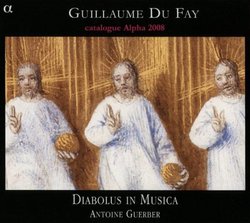Devilishly Well Sung!
Giordano Bruno | Wherever I am, I am. | 09/20/2008
(5 out of 5 stars)
"Careful! This is NOT the goth-rock CD "Diabolus in Musica" by an ensemble that calls itself Slayer. This is a fantastically fine performance of a polyphonic mass by Guillaume Dufay (c1400-1474), the very best peformance of Missa Se La Face Ay Pale I've ever heard recorded.
Diabolus in Musica, the name of this French vocal ensemble, is a musical jest. "The Devil in Music" refers to the interval of the augmented fourth - called the tritone - which was 'prohibited in music of Dufay's era and which still jars my ears today. An example would be a leap from F to B-natural. Avoiding the tritone is one of the tricks a performing musician must learn to do automatically, even if the correction is not notated in manuscript.
Dufay was as well known and widely respected as any composer of his era, for which reason we know more about his life than about any of his contemporaries. Not only a singer and a composer, Dufay was an active priest and eventually a busy clerical administrator of the Cambrai cathedral. Despite the respect paid him by younger composers, including Ockeghem and Busnois, Dufay was essentially the culmination of his school, the last medieval voice before the advent of the international Franco-Flemish style represented best by Josquin des Prez.
Missa Se La Face Ay Pale is based on a secular love-song, written by Dufay himself. It uses the 'cantus' melody of that chanson as the structural element of each movement of the mass, sung in long note values by the tenors. Though the mass is polyphonic, there's little of the imitative counterpoint typical of Josquin. Instead the four voices seem to intertwine with great freedom and spontaneity. In fact, such is far from true; this "isorhythmic" mass is tightly formulated on strict mathematical calculations of proportion, using Pythagorean ratios, the 'golden number', and the Fibonaci sequence. Mathematicians! There's a challenge for you! Can you hear math as well as solve it? Believe me, it's there. I've seen the original notation.
Diabolus in Musica is committed to a high standard of historical authenticity. Only male singers and no instruments would ever have performed this music under Dufay's direction, and the Cambrai Cathedral records clearly demonstrate that singing with two voices per part was the norm. That's how DiM has recorded. Listeners who like a robust choir sound will be pleased by the performance; the voices will fill your spaces. Listeners who want incisive articulation, careful tuning, and independence of polyphonic phrasing will also be pleased, since this is a diabolically tight ensemble. The mass is interspersed with liturgically appropriate plainchant and harmonized chant, all sung beautifully.
There are only three other CDs I would choose to recommend, of masses by Dufay: another by Diabolus, Mille Bonjours; the Missa Puisque Je Vis sung by the Binchois Consort; and the Missa Ecce Ancilla Domini sung by the Ensemble Gilles Binchois. This Se La Face might be the pick of the pack."
Liturgical Music from the 15th Century's Most Renowned Perfo
EquesNiger | Prague, Czech Republic | 05/06/2008
(5 out of 5 stars)
"Once again, Antione Guerber and Diabolus In Musica take us to the brilliant Guillaume Du Fay. Du Fay started from modest beginnings, the illegitimate son of a priest and a "lady", but rose quickly through the ranks in the Church and became the early-Renaissance's most celebrated and popular composer.
In this CD, we're treated to Du Fay's liturgical pieces, reflecting the foundation of all of his work to follow. First rate performances by Diabolus in Musica, including uplifting vocal performances, make this an outstanding piece of work, preferable even to "Mille Bounjours", the companion CD dealing with Du Fay's secular works. Excellent music for a lengthy drive."


 Track Listings (11) - Disc #1
Track Listings (11) - Disc #1





